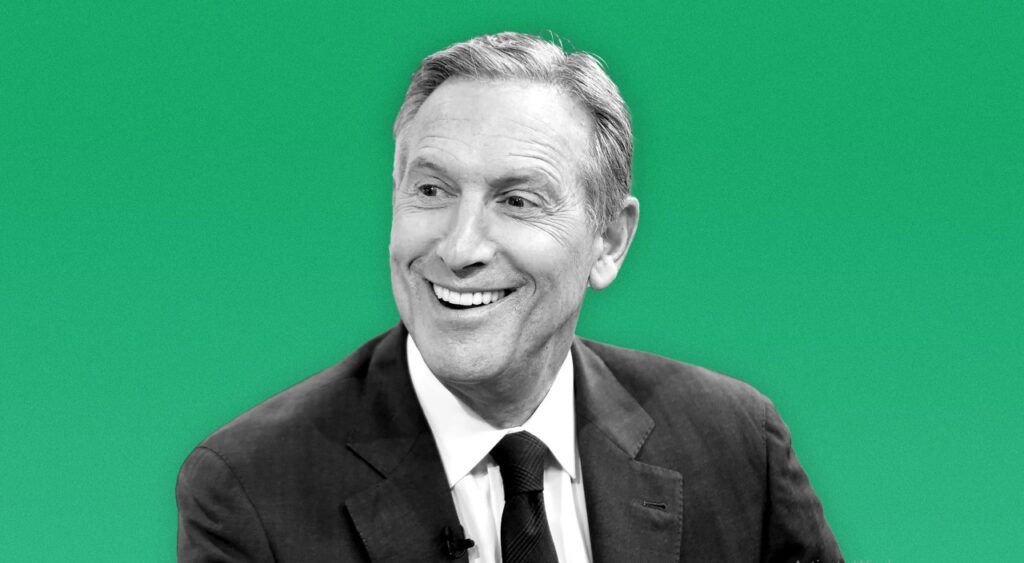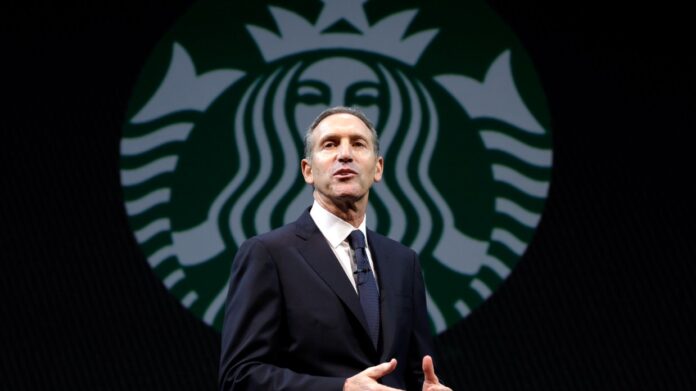The former CEO of Starbucks, Howard Schultz, is expected to be worth $5.8 billion as of 2025. By transforming Starbucks from a local coffee chain into a worldwide brand, Schultz revolutionized coffee culture and established one of the most recognizable businesses in the world. His goal of turning Starbucks into a multinational chain of coffee shops is primarily responsible for his success. In addition to his wealth from Starbucks, Schultz owns real estate and other enterprises. Even after leaving his position as CEO, Schultz continues to have a significant impact on the business and charitable sectors.
Table of Contents
Howard Schultz’s Wife and Children
The millionaire business magnate who made Starbucks a major force in the world, Howard Schultz, has always given his family a lot of credit for his success. He married Sheri Kersch Schultz in 1982, and they are now wed. As a philanthropist, Sheri is a co-founder of the Schultz Family Foundation, which supports veterans and youth jobs. Addison Schultz and Jordan Schultz are the couple’s children. Despite Howard’s prominent public image, the Schultz family keeps their private lives private, preserving a grounded and close-knit family life out of the spotlight.
Humble Beginnings
Born in Brooklyn, New York, on July 19, 1953, Howard Schultz came from a working-class household. Growing up in the Canarsie Bayview Projects’ public housing, Schultz saw firsthand the financial hardships of his family, particularly his father, who had a string of low-wage jobs with no benefits or stability. These early encounters had a significant impact on Schultz’s beliefs on company ethics and employee welfare.
Schultz, a first-generation college student, studied communications at Northern Michigan University after receiving a football scholarship. He worked in marketing and sales after graduating in 1975, eventually rising to the position of director of sales for a Swedish firm that produced coffee makers and home goods.
Discovering Starbucks
When Howard Schultz was employed at Hammerplast in 1981, he saw that Starbucks, a tiny coffee firm in Seattle, was placing an abnormally large order for drip coffee makers. He was captivated by the company’s enthusiasm for premium coffee when he went out of curiosity.
In 1982, Schultz became the director of marketing and retail operations of Starbucks. But all changed in 1983 during a vacation to Milan, Italy. The experience, the craftsmanship, and the sense of community seen in Italian coffee bars served as his inspiration. By importing this culture to America, Schultz hoped to make Starbucks a hub for connection as much as coffee.
The Leap That Changed Everything
The original proprietors of Starbucks were dubious about Schultz’s plan to transform their retail establishment into a café with an espresso bar. Unfazed, Schultz quit Starbucks in 1985 to launch Il Giornale, a rapidly successful coffee business. He amassed enough money by 1987 to purchase Starbucks from its original creators for $3.8 million, which he then combined with Il Giornale.
Starbucks saw a swift turnaround under Schultz’s direction. He changed the name to a premium coffee experience, added espresso-based drinks, and placed more of an emphasis on the store’s decor, atmosphere, and customer service. Starbucks evolved become a “third place” between home and work, going beyond simply being a coffee shop.
Scaling the Brand Globally
Howard Schultz actively grew Starbucks both domestically and abroad during the 1990s and 2000s. Starbucks operated hundreds of locations throughout the globe by the late 2000s. After resigning as CEO in 2000, Schultz reappeared in 2008 as the firm struggled with overexpansion and dwindling sales.
Refocusing on the brand’s key values—quality, customer experience, and staff engagement—marked his second term as CEO. Schultz rekindled Starbucks’ growth by closing failing locations, introducing loyalty programs, and investing in digital innovation.
Starbucks had more than 28,000 locations across more than 75 countries at the time he resigned in 2017.
Employee-Centric Leadership
His dedication to the welfare of his employees is among Howard Schultz’s most enduring legacy. In addition to providing healthcare benefits, stock options (Bean Stock), and college tuition assistance—even for part-time employees—he called Starbucks employees “partners.”
His early recollections of his father getting hurt at work without health insurance influenced this mentality. Schultz pledged to create a business that respected and treated its employees with dignity. He helped establish a more compassionate business culture in America in a number of ways.
Political Aspirations
When he Howard Schultz hinted at a possible independent presidential bid in the 2020 U.S. elections, Howard Schultz made news in 2019. His declaration spurred national discussion regarding third-party candidates and the political system, even if he eventually chose not to run. He urged for a more moderate, solutions-focused approach to governing and voiced worries about how polarizing American politics are.
Howard Schultz: From Poverty to Starbucks Billionaire

It is quite inspiring to read about Howard Schultz’s journey from a low-income Brooklyn neighbourhood to creating a multinational coffee empire. His tale serves as a potent reminder that your starting point does not limit your potential. Driven by aspiration, foresight, and compassion, Schultz transformed the way people enjoy coffee, transforming Starbucks into a global cultural icon. He is more than simply a businessman; to people who dare to dream above their circumstances, he represents hope. Schultz stands out as evidence that anybody can advance, even from the bottom, with perseverance and audacious thinking in a society where success frequently appears hereditary.



